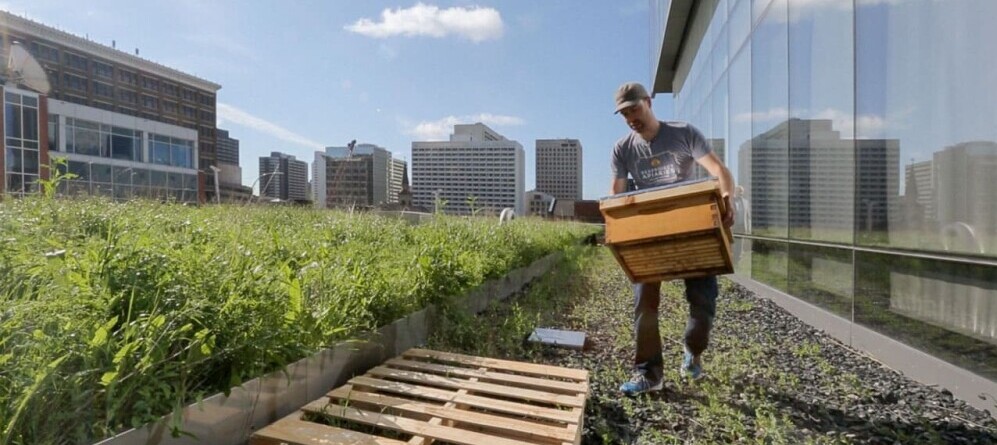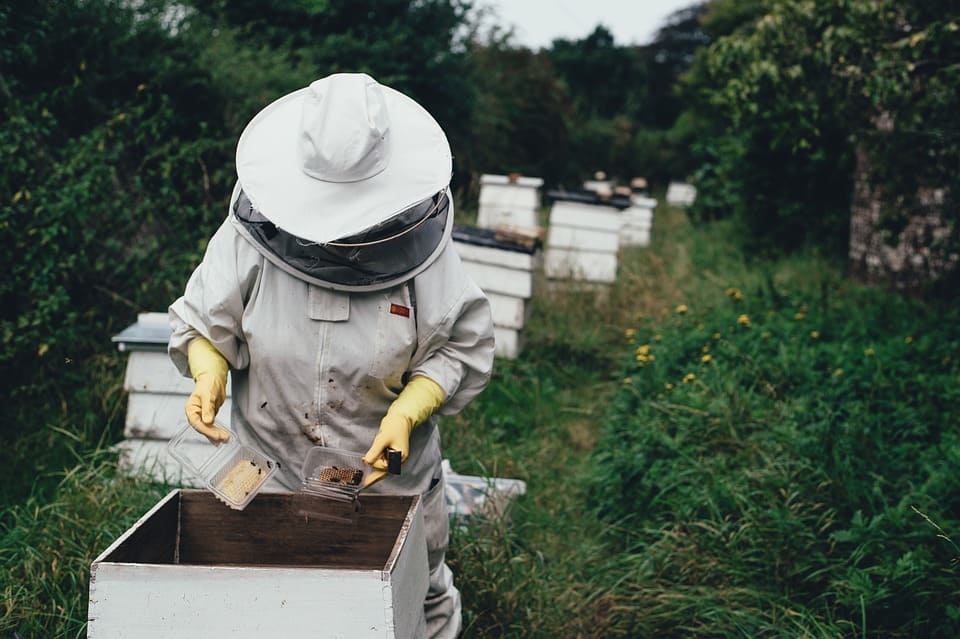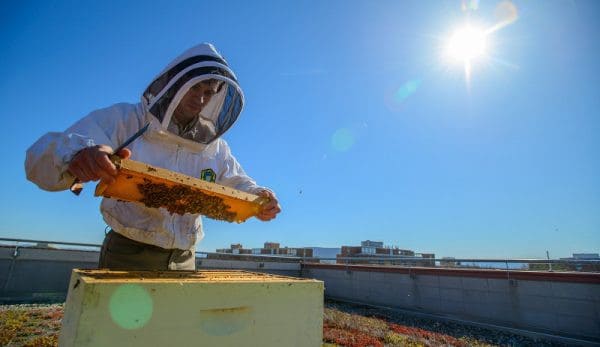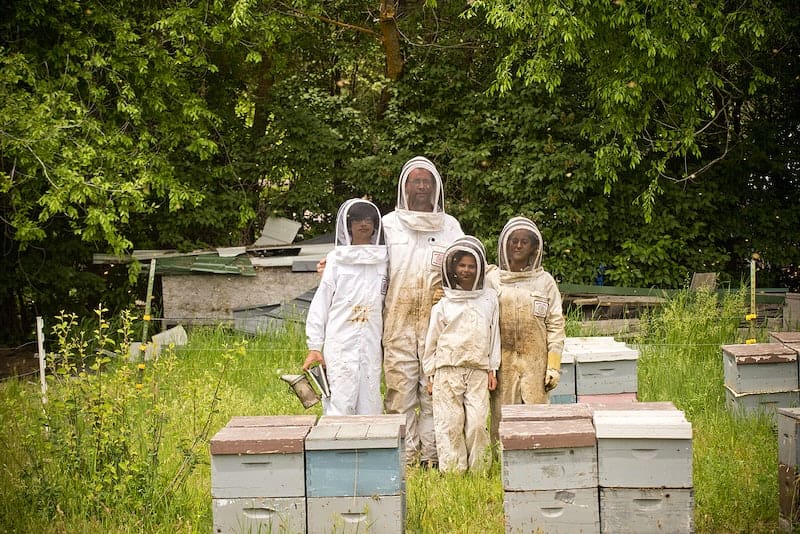The Ultimate Guide to Urban Beekeeping: Finding the Ideal Hive Location
- Introducing Urban Beekeeping: Benefits and Challenges
- Understanding Local Regulations and Community Considerations
- Evaluating Potential Hive Locations: Sunlight, Wind Protection, and Accessibility
- Utilizing Rooftops, Balconies, and Community Gardens for Hive Placement
- Assessing Safety Concerns: Human and Pet Interaction
- Tips from Experienced Urban Beekeepers: Case Studies and Success Stories
 The importance of bees to our ecosystem cannot be overstated, and it’s heartening to see a growing interest in urban beekeeping. No longer the sole province of country folk, beekeeping in cities and suburbs has exploded in popularity over the last decade.
The importance of bees to our ecosystem cannot be overstated, and it’s heartening to see a growing interest in urban beekeeping. No longer the sole province of country folk, beekeeping in cities and suburbs has exploded in popularity over the last decade.
Urban beehives existed as far back as the 1950s, although local ordinances often restricted beekeeping within city limits. Thankfully, many of these laws have been overturned, making it possible for anyone to keep a beehive in their backyard.
Honey has been used for everything from hay fever remedies to antiseptics; no one knows this better than a beekeeper. As more and more people focus on organic, locally sourced foods and the bee population continues to decline, it’s no surprise that more people are discovering the joys of beekeeping.
Even if you lead a busy life in the city, beekeeping can be within reach. Urban beekeeping has become a global phenomenon, with thriving hives in cities worldwide.
While it may seem counterintuitive to keep bees in an urban environment, studies have shown that city bees are often more productive and healthier than their rural counterparts. The warm urban climate and diverse plant life are factors, along with the lower concentrations of insecticides used in modern farming.
Whether you have access to a small backyard, a city allotment, or a rooftop, urban beekeeping is a rewarding and accessible hobby for anyone who wants to get involved.
Our comprehensive urban beekeeping guide is designed to be a starting point for learning the basics of beekeeping in the city. Join us in the urban beekeeping world and discover these amazing creatures’ wonders for yourself!
Table of Contents
Starting Urban Beekeeping: A Journey into a Buzzing World
The humble honey bee plays a vital role in our ecosystem and has become the focus of many people who want to start urban beehives in cities and suburban areas. With a growing interest in organic, local foods and a rapid decline in bee populations, beekeeping has become a rewarding hobby that more and more people are taking up.
However, keeping bees is a commitment and requires research to ensure that you have the space, time, and equipment to look after them adequately long term.
To start, it’s essential to find reliable resources to gather information on beekeeping, from the British Beekeepers Association to hobby bloggers who have started just like you. By reaching out to experts and talking to beekeepers in your local area, you can ensure that beekeeping is a good fit for you.
Before you get your bees, it’s essential to check that it is legal to keep bees in your area and obtain the correct permissions. Your bees will need to be located near an appropriate water source and should be protected from vandals. Be sure to speak to your neighbors to make sure they don’t have any objections to you keeping bees nearby.
After completing the necessary research and obtaining the correct permissions, the fun begins. You’ll need to build or purchase your hives and invest in all the equipment you’ll need to take care of them. Online guidance can help you determine the size and setup of your hives and what equipment you’ll need in the beginning.
 Photo: Penn State – Flickr
Photo: Penn State – Flickr
When choosing your bees, it’s essential to consider their impact on the local environment. Native bees are a sustainable choice that will not disrupt the local eco structure.
Joining a beekeeping society or local beekeeping group or taking a course is a great way to gain access to support and expert advice. Beekeeping associations provide training, advice, and local knowledge essential for urban beekeeping.
The British Beekeepers Association, for example, offers specialist advice, courses, and qualifications to help improve your beekeeping skills. Your local area may also have a beekeeping group that can provide guidance, source bees and equipment, and add a social element to keeping bees.
By taking the time to research, plan, and seek guidance, you can join the ranks of the growing number of urban beekeepers and enjoy the unique and rewarding experience of beekeeping.
Taking Care of Your Hive and Harvesting Honey
Beekeeping is a rewarding activity that allows you to not only produce your honey but also helps support the bee population, which is vital to the pollination of plants. However, proper care and management of your hive are essential to ensure the health and productivity of your bees.
In this guide, we’ll discuss how to manage your hive and harvest honey while keeping yourself and your bees safe.
Managing the Hive
Beekeepers have different approaches to caring for their bees, so you’ll need to develop your own methods that work best for you. Regular inspections are essential to monitor the health of your bees and prevent the spread of diseases and pests.
During swarming and harvesting seasons, you’ll need to devote more time to caring for your bees, as these periods can be more labor-intensive.
When managing your hive, safety should always be your top priority. Many beekeepers prefer to wear a full protective suit, while more experienced beekeepers often wear just a veil and jacket.
It’s essential to check for bee sting allergies in yourself, your family, and your pets. Taking appropriate precautions will ensure the safety of yourself, your family, pets, neighbors, and your bees.
Harvesting Your Honey
One of the most satisfying aspects of beekeeping is harvesting the golden nectar of honey. However, this process requires careful planning and execution.
A smoker is a critical tool to have during the harvesting process, as it helps calm the bees and mask their chemical communication. You can use commercially available smoker fuel or natural materials such as pine needles or untreated wood.
It’s important to remember that you should not harvest the dark honey found in the brood area, as it’s essential for the bees to feed their young. You should also leave enough honey for the bees to survive the winter months to maintain the hive’s strength.
 Photo: Max pixel
Photo: Max pixel
As an expert beekeeper, I am often asked how much honey and beeswax can be harvested from an urban beehive. It’s a common question for those considering taking up the rewarding beekeeping hobby.
The answer depends on various factors, including the colony’s size, the type of hive, the location, and the weather. Typically, a single urban beehive can produce between 20-60 pounds of honey in each harvest. But it’s not just honey that can be harvested from a hive – beeswax is also a valuable resource that can be used in all ways.
For centuries, beeswax has been used to make candles and is an ingredient in soap, lip balm, and beauty products. It’s a versatile material with various uses beyond the honey that bees produce.
Another product that can be harvested from hives is bee pollen, which is highly sought after for its antioxidant qualities and supposed ability to boost the immune system.
When it comes time to harvest, the process is relatively straightforward. Extract the frames, uncap the honeycomb with a knife, and place the frames in an extractor. The extractor spins the frames using centrifugal force to remove the liquid honey, which can then be collected, filtered, and bottled.
In conclusion, urban beekeeping can be a fascinating and rewarding experience that provides a sweet reward and a wealth of valuable resources such as beeswax and bee pollen. With the right tools and knowledge, harvesting honey and other products from your urban beehive can be a straightforward and enjoyable experience.
Tips For Starting a Beehive
Beekeeping is a fascinating hobby that provides many benefits, including fresh, natural honey and helping protect the environment by promoting pollination. However, before starting a beehive, it’s essential to follow the necessary steps to ensure the safety of your bees and your community.
First and foremost, check your local laws to confirm that beekeeping is permitted in your area. Many cities and towns have specific regulations and bylaws that govern beekeeping, and it’s adhering to them is vital.
In some states, you may need to obtain an Apiary License to keep bees. This process ensures that your beehive’s location has been approved and meets all of the state’s regulatory requirements.
After confirming that beekeeping is legal in your area, you’ll need to select the right location for your beehive. Bees are very territorial and protective of their hives, so it’s crucial to choose a spot that is secluded and far from high foot traffic areas.
It’s also essential to inform anyone living or working nearby of the hive’s presence to prevent accidents.
If you have a garden, it’s an ideal location for a beehive. Even if you have a small garden, beehives are typically no more than two or three feet high and a little over a foot square on the base, making them suitable for even the most minuscule yards.
Experts suggest placing the hive at least ten feet from regularly used areas. For small spaces, creating a barrier of shrubs or a fence around the hive can help direct the bees’ flight path away from ground level.
If you live in an apartment, consider placing the hive on a balcony or roof deck that isn’t frequently used. Following the exact distance requirements for a garden placement is essential in this case.
If you’re feeling adventurous, consider an indoor beehive. Internal hives usually attach to an outside wall with a cavity allowing the bees to get outside. Although it’s an exciting option, it’s crucial to inform your neighbors of the hive’s presence and select a quieter strain of bees that are less likely to swarm.
Suppose you’re new to beekeeping and looking for an innovative and user-friendly beehive system. In that case, BEEcosystem is an excellent option. This modular hexagonal hive is made of cedarwood and has clear panels that allow you to see into the hive.
In conclusion, starting a beehive can be a rewarding and fulfilling experience, but it’s vital to ensure that you’re following all the necessary steps to keep your bees safe and your community protected. By selecting the right location, informing your neighbors, and following local laws, you’ll be well on your way to creating a thriving beehive.
Essential Equipment and Considerations
If you are a beginner beekeeper, don’t rush to spend money on equipment before consulting with a local beekeepers’ club. Members can offer valuable local insights, tips, and tricks to help avoid common mistakes and guide you on equipment purchases.
They may even know of places to get equipment at a discounted price. Remember, buying second-hand equipment is not recommended as it may be infected with a disease that can harm your colony.
Choosing the Right Beehive Box
Selecting the correct beehive box is crucial for creating a safe and comfortable environment for your bees. Consider the specific needs of your environment and seek professional advice to make the right choice. It’s Investing in high-quality materials for a professional look and minimizing disturbance to your neighbors is best.
As a seasoned beekeeping expert, the age-old question I’m often asked is, “Which type of beehive is the best?” You’ll probably end up purchasing a hive off-the-shelf if you’re not a skilled DIYer with expert carpentry skills.
With numerous designs available, each specific to a particular location and climate, it’s essential to consider the hive’s suitability before making a purchase.
 Photo: rawpixel.com
Photo: rawpixel.com
In Europe and North America, four types of hives are commonly used: the Langstroth Hive, Top Bar Hive, Warre Hive, and Flow Hive.
First on the list is the Langstroth Hive, the most popular hive design worldwide. It is named after its inventor, Reverend Lorenzo Langstroth. The hive’s significant advantage is its frame design, which is ideal for bees to create honeycombs.
The frames’ spacing is perfect, allowing ample space for the bees to move around. The hive’s internal system makes it easy to inspect and harvest the honey for any issues.
Second, the Top Bar Hive is a simple backyard beehive that’s common in developing countries. The bees create their honeycomb on the top bar, but the comb is not in a regular pattern, resembling the natural honeycombs in the wild. However, it can only hold a small colony due to its limited space.
The Warre Hive, derived from the Top Bar hive, is noted for its quick and easy assembly. It also mimics how bees construct their honeycombs in the wild. Experts suggest that this hive is suitable for sustaining the bee population rather than for high honey production.
The Flow Hive, a relatively new concept from Australia, allows surplus honey to flow from the hive without the need to smoke the bees. The interior is designed to collect surplus honey and allow it to flow out of the hive for collection. Additional frames can be added to increase its capacity.
Lastly, based on the Langstroth design, the Five-Frame Nuc Hive is ideal for raising a new queen and creating a swarm. Since it’s small and portable, it’s often used to transport swarms. Its use can be limited since it only has five frames, leaving no room for expansion.
In conclusion, the best beehive for you depends on your specific needs and goals. Consider your location and climate, the colony’s size, and desired honey production. A beehive is a crucial investment in the sustainability of the bee population, and choosing the right one can make all the difference.
The Essentials
To get started with your beehive, you will need a few essentials:
- Hive Stand: This elevates the hive off the ground and helps to prevent moisture damage by providing sufficient ventilation.
- Bottom Board: Choose a solid or mesh board, depending on your preference. A solid board keeps the hive warm during the winter and deters predators, such as ants, from attacking the bees. On the other hand, the screen board allows mites to fall through the mesh, ensuring a cleaner and healthier environment for your bees.
- Deep Hive Body: This is where the honeycombs are housed and where bees live. A standard hive can hold 8-10 frames, and most hives have two deep hive bodies: one for the brood chamber in the lower part of the hive, and the other for the food chamber at the top.
- Frames: These wooden foundations are where the bees build their honeycombs. While plastic frames are available, they do not work as well as traditional wooden frames.
- Shallow Chamber: Use this chamber to collect surplus honey from the hive during the honey season.
- Inner and Outer Cover: These provide air circulation and are made of durable materials such as cedarwood or cypress, or even plastic for the outer cover which is long-lasting and will maintain its appearance over time.
- Feeders: During the winter, hive feeders are necessary as the bees can’t collect enough flower nectar to survive the cold weather. A feeder provides them with sugar water to sustain them through the lean months.
- Smoker: This beekeeping tool is essential for calming the bees and making it easier to collect honey when it’s time to harvest.
- Frame Lifter: A small device that helps you remove the frames from the hive if they become stuck together by the comb.
- Bee-Proof Suit: Only experienced beekeepers can handle bees without protection. A bee-proof suit includes overalls, gloves, and a veil or mask to protect your face.
- A Swarm of Bees with a Queen: The final piece of the puzzle for a thriving hive is a swarm and their queen. The Italian bee variety is the best choice for beginners as they are calm and productive. Other cross-bred varieties, such as Buckfast and Cordovan hybrids, are efficient and productive in honey production. However, avoid the African hybrid, which is very territorial and has a reputation for swarming and attacking humans. Other varieties available are the Carniolan, Russian, and Caucasian bees.
 Photo: Peakpx
Photo: Peakpx
In summary, starting a beehive requires essential equipment and careful consideration of the specific needs of your environment. Seeking professional advice and investing in high-quality materials is critical for creating a safe and comfortable environment for your bees.
With the right equipment and approach, you can create a thriving beehive and enjoy the benefits of fresh honey production.
If you would like to receive the monthly newsletter from Beewhisperer360 drop your email address in the comments section.
